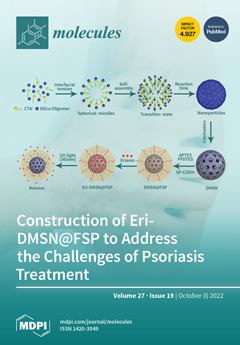The adsorption of helium on charged hexabenzocoronene (Hbc, C
42H
18), a planar polycyclic aromatic hydrocarbon (PAH) molecule of
D6h symmetry, was investigated by a combination of high-resolution mass spectrometry and classical and quantum computational methods. The ion abundance
[...] Read more.
The adsorption of helium on charged hexabenzocoronene (Hbc, C
42H
18), a planar polycyclic aromatic hydrocarbon (PAH) molecule of
D6h symmetry, was investigated by a combination of high-resolution mass spectrometry and classical and quantum computational methods. The ion abundance of He
nHbc
+ complexes versus size
n features prominent local anomalies at
n = 14, 38, 68, 82, and a weak one at 26, indicating that for these “magic” sizes, the helium evaporation energies are relatively large. Surprisingly, the mass spectra of anionic He
nHbc
− complexes feature a different set of anomalies, namely at
n = 14, 26, 60, and 62, suggesting that the preferred arrangement of the adsorbate atoms depends on the charge of the substrate. The results of our quantum calculations show that the adsorbate layer grows by successive filling of concentric rings that surround the central benzene ring, which is occupied by one helium atom each on either side of the substrate. The helium atoms are fairly localized in filled rings and they approximately preserve the
D6h symmetry of the substrate, but helium atoms in partially filled rings are rather delocalized. The first three rings contain six atoms each; they account for magic numbers at
n = 14, 26, and 38. The size of the first ring shrinks as atoms are filled into the second ring, and the position of atoms in the second ring changes from hollow sites to bridge sites as atoms are filled into the third ring. Beyond
n = 38, however, the arrangement of helium atoms in the first three rings remains essentially frozen. Presumably, another ring is filled at
n = 68 for cations and
n = 62 for anions. The calculated structures and energies do not account for the difference between charge states, although they agree with the measurements for the cations and show that the first solvation shell of Hbc
± is complete at
n = 68. Beyond that size, the adsorbate layer becomes three-dimensional, and the circular arrangement of helium changes to hexagonal.
Full article






